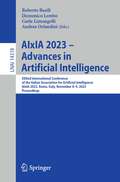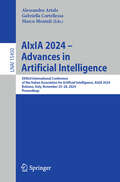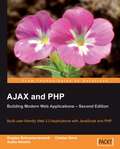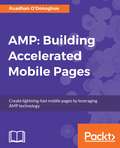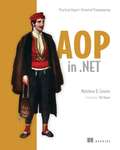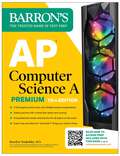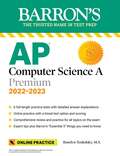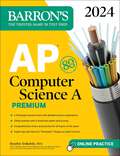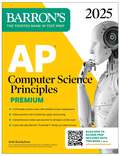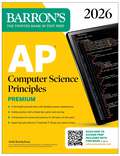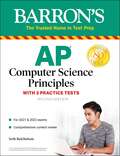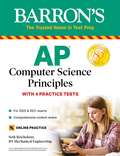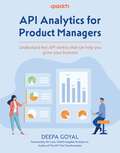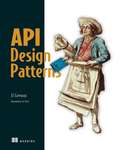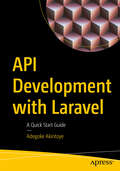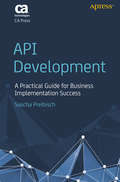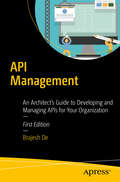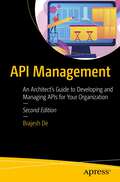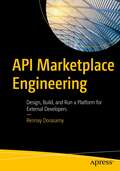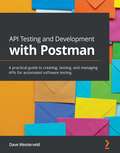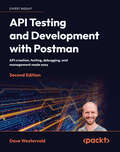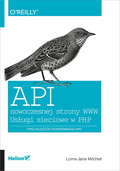- Table View
- List View
AIxIA 2023 – Advances in Artificial Intelligence: XXIInd International Conference of the Italian Association for Artificial Intelligence, AIxIA 2023, Rome, Italy, November 6–9, 2023, Proceedings (Lecture Notes in Computer Science #14318)
by Roberto Basili Domenico Lembo Andrea Orlandini Carla LimongelliThis book constitutes the refereed proceedings of the XXIInd International Conference on AIxIA 2023 – Advances in Artificial Intelligence, AIxIA 2023, held in Rome, Italy, during November 6–10, 2023.The 33 full papers included in this book were carefully reviewed and selected from 53 submissions. They were organized in topical sections as follows: Argumentation and Logic Programming, Natural Language Processing, Machine Learning, Hybrid AI and Applications of AI.
AIxIA 2024 – Advances in Artificial Intelligence: XXIIIrd International Conference of the Italian Association for Artificial Intelligence, AIxIA 2024, Bolzano, Italy, November 25–28, 2024 Proceedings (Lecture Notes in Computer Science #15450)
by Marco Montali Alessandro Artale Gabriella CortellessaThis book constitutes the refereed proceedings of the XXIIIrd International Conference on AIxIA 2024 – Advances in Artificial Intelligence, AIxIA 2024, held in Bolzano, Italy, during November 25–28, 2024. The 24 full papers and 1 invited paper included in this volume were carefully reviewed and selected from 41 submissions. The papers cover the following topics: artificial intelligence; journals; Natural Language Processing, Machine Learning, Hybrid AI and Applications of AI.
AJAX and PHP: Building Modern Web Applications 2nd Edition
by Bogdan Brinzarea Audra HendrixThis book is a step-by-step, example-driven AJAX tutorial, featuring complete case studies. Each chapter contains a friendly mix of theory and practice, so that your journey through the book will be pleasant, yet efficient. You'll be coding your first AJAX application at the end of the first chapter, and with each new chapter you'll develop increasingly complex AJAX applications featuring advanced techniques and coding patterns. AJAX and PHP: Building Modern Web Applications, 2nd Edition, is written for PHP developers who: Want to learn how to use PHP, JavaScript, MySQL and jQuery to implement Web 2.0 applications Are looking for a step-by-step, example-driven AJAX tutorial Want to learn advanced AJAX coding patterns and techniques and be able to assess the security and SEO implications of their code
AJAX and PHP: Building Responsive Web Applications
by Bogdan BrinzareaThis book is for web developers willing to build better web applications. A basic knowledge of PHP, XML, JavaScript and MySQL, or a strong will to learn-as-you-type, is assumed.
AMP: Building Accelerated Mobile Pages
by Ruadhan O'DonoghueEngineer naturally lean web pages and leverage the latest web platform features to dramatically boost page speed About This Book • The first book for web developers that shows how to put AMP to work • Improve your website's mobile experience and get more traffic • Practical methods to achieve a step change in performance quickly and easily Who This Book Is For This book is for experienced web developers who are aware of the impact of slow-loading web pages on conversion rates and user engagement, and who are seeking to serve content to their end users in a rich and enticing way using the Accelerated Mobile Pages framework. You should be familiar with HTML5, CSS3, JavaScript, and JSON. What You Will Learn • Build, validate, and deploy AMP pages • Create interactive user notifications, navigation menus, accordions, contact pages with forms and maps • Monetize your traffic with a variety of ad styles and providers • Analyze your traffic by integrating analytics providers and tracking user-behavior along several dimensions • Embed social media with amp-youtube, amp-instagram, amp-twitter, and amp-facebook • Build e-commerce functionality including product pages and shopping carts • Deliver rich media experiences using AMP custom elements • Use advanced deployment techniques to extend functionality • Install ServiceWorkers and build Progressive Web Apps for offline use In Detail Google introduced the Accelerated Mobile Pages (AMP) project to give mobile users lightning-fast response times when accessing web pages on mobile devices. AMP delivers great user experiences by providing a framework for optimizing web pages that otherwise would take much longer to load on a mobile platform. This book shows how to solve page performance issues using the mobile web technologies available today. You will learn how to build instant-loading web pages, and have them featured more prominently on Google searches. If you want your website to succeed on mobile, if you care about SEO, and if you want to stay competitive, then this book is for you! You will go on a mobile web development journey that demonstrates with concrete examples how to build lightning-fast pages that will keep your visitors on-site and happy. This journey begins by showing how to build a simple blog article-style web page using AMP. As new concepts are introduced this page is gradually refined until you will have the skills and confidence to build a variety of rich and interactive mobile web pages. These will include e-commerce product pages, interactive forms and menus, maps and commenting systems, and even Progressive Web Apps. Style and approach Get step-by-step instructions to build web pages of different types, gain expert tricks to brand your pages without bloating them, and see methods to embed advertising.
AOP in .NET: Practical Aspect-Oriented Programming
by Matthew GrovesSummaryAOP in .NET introduces aspect-oriented programming to .NET developers and provides practical guidance on how to get the most benefit from this technique in your everyday coding. The book's many examples concentrate on modularizing non-functional requirements that often sprawl throughout object-oriented projects. Even if you've never tried AOP before, you'll appreciate the straightforward introduction using familiar C#-based examples. AOP tools for .NET have now reached the level of practical maturity Java developers have relied on for many years, and you'll explore the leading options, PostSharp, and Castle DynamicProxy.About the TechnologyCore concerns that cut across all parts of your application, such as logging or authorization, are difficult to maintain independently. In aspect-oriented programming (AOP) you isolate these cross-cutting concerns into their own classes, disentangling them from business logic. Mature AOP tools like PostSharp and Castle DynamicProxy now offer .NET developers the level of support Java coders have relied on for years.About this BookAOP in .NET introduces aspect-oriented programming and provides guidance on how to get the most practical benefit from this technique. The book's many examples concentrate on modularizing non-functional requirements that often sprawl throughout object-oriented projects. You'll appreciate its straightforward introduction using familiar C#-based examples.This book requires no prior experience with AOP. Readers should know C# or another OO language.What's InsideClear and simple introduction to AOPMaximum benefit with minimal theoryPostSharp and Castle DynamicProxyPurchase of the print book includes a free eBook in PDF, Kindle, and ePub formats from Manning Publications.About the AuthorMatthew D. Groves is a developer with over ten years of professional experience working with C#, ASP.NET, JavaScript, and PHP.Table of ContentsPART 1 GETTING STARTED WITH AOPIntroducing AOPAcme Car RentalPART 2 THE FUNDAMENTALSOF AOPCall this instead: intercepting methodsBefore and after: boundary aspectsGet this instead: intercepting locationsUnit testing aspectsPART 3 ADVANCED AOP CONCEPTSAOP implementation typesUsing AOP as an architectural toolAspect composition: example and execution
AP Computer Science A Premium, 12th Edition: Prep Book with 6 Practice Tests + Comprehensive Review + Online Practice (Barron's AP Prep)
by Roselyn Teukolsky M.S.Be prepared for exam day with Barron&’s. Trusted content from AP experts!Barron&’s AP Computer Science A Premium, 12th Edition includes in‑depth content review and practice. It&’s the only book you&’ll need to be prepared for exam day. Written by Experienced EducatorsLearn from Barron&’s‑‑all content is written and reviewed by AP expertsBuild your understanding with comprehensive review tailored to the most recent examGet a leg up with tips, strategies, and study advice for exam day‑‑it&’s like having a trusted tutor by your sideBe Confident on Exam DaySharpen your test‑taking skills with 6 full‑length practice tests–3 in the book, including a diagnostic test to target your studying, and 3 more online–plus detailed answer explanations for all questionsStrengthen your knowledge with in‑depth review covering all units on the AP Computer Science A examReinforce your learning with dozens of clear examples and a series of multiple‑choice practice questions at the end of each review chapterLearn the key techniques and methods of modern programming with a chapter devoted to the Java language features you need to know for test dayRobust Online PracticeContinue your practice with 3 full‑length practice tests on Barron&’s Online Learning HubSimulate the exam experience with a timed test optionDeepen your understanding with detailed answer explanations and expert adviceGain confidence with scoring to check your learning progress
AP Computer Science A Premium, 2022-2023: 6 Practice Tests + Comprehensive Review + Online Practice (Barron's Test Prep)
by Roselyn Teukolsky M.S.Be prepared for exam day with Barron&’s. Trusted content from AP experts! Barron&’s AP Computer Science A Premium: 2022-2023 includes in-depth content review and online practice. It&’s the only book you&’ll need to be prepared for exam day.Written by Experienced EducatorsLearn from Barron&’s--all content is written and reviewed by AP expertsBuild your understanding with comprehensive review tailored to the most recent examGet a leg up with tips, strategies, and study advice for exam day--it&’s like having a trusted tutor by your sideBe Confident on Exam DaySharpen your test-taking skills with 6 full-length practice tests--3 in the book, including a diagnostic test to target your studying, and 3 more onlineStrengthen your knowledge with in-depth review covering all Units on the AP Computer Science A ExamReinforce your learning with multiple-choice practice questions at the end of each chapterOnline PracticeContinue your practice with 3 full-length practice tests on Barron&’s Online Learning HubSimulate the exam experience with a timed test optionDeepen your understanding with detailed answer explanations and expert adviceGain confidence with scoring to check your learning progress
AP Computer Science A Premium, 2024: 6 Practice Tests + Comprehensive Review + Online Practice (Barron's AP)
by Roselyn Teukolsky M.S.Be prepared for exam day with Barron&’s. Trusted content from AP experts!Barron&’s AP Computer Science A Premium, 2024 includes in-depth content review and online practice. It&’s the only book you&’ll need to be prepared for exam day.Written by Experienced EducatorsLearn from Barron&’s--all content is written and reviewed by AP expertsBuild your understanding with comprehensive review tailored to the most recent examGet a leg up with tips, strategies, and study advice for exam day--it&’s like having a trusted tutor by your sideBe Confident on Exam DaySharpen your test-taking skills with 6 full-length practice tests--3 in the book, including a diagnostic test to target your studying, and 3 more onlineStrengthen your knowledge with in-depth review covering all Units on the AP Computer Science A ExamReinforce your learning with multiple-choice practice questions at the end of each chapterOnline PracticeContinue your practice with 3 full-length practice tests on Barron&’s Online Learning HubSimulate the exam experience with a timed test optionDeepen your understanding with detailed answer explanations and expert adviceGain confidence with scoring to check your learning progress
AP Computer Science A: With 6 Practice Tests (Barron's Test Prep)
by Roselyn Teukolsky M.S.Barron&’s AP Computer Science A is completely up-to-date for the May 2020 exam changes. The course outline and free response questions reflect updates to the topics breakdown and free-response section. You&’ll get the key content review, practice tests, and effective strategies you need to be prepared for the exam. This edition features:Five full-length practice tests, including three onlineOne diagnostic test to help you determine which sections you need to focus onSpecific strategies for the AP Computer Science A examComprehensive content reviewGlossary of useful computer terms
AP Computer Science Principles Premium, 2025: Prep Book With 6 Practice Tests + Comprehensive Review + Online Practice (Barron's AP Prep)
by Seth ReichelsonBe prepared for exam day with Barron&’s. Trusted content from AP experts! Barron&’s AP Computer Science Principles Premium, 2025 includes in-depth content review and online practice. It&’s the only book you&’ll need to be prepared for exam day.Written by Experienced Educators Learn from Barron&’s--all content is written and reviewed by AP experts Build your understanding with comprehensive review tailored to the most recent exam Get a leg up with tips, strategies, and study advice for exam day--it&’s like having a trusted tutor by your side Be Confident on Exam Day Sharpen your test‑taking skills with 6 full‑length practice tests–3 in the book, including a diagnostic test to target your studying, and 3 more online–plus detailed answer explanations for all questions Strengthen your knowledge with in‑depth review covering all Big Ideas on the AP Computer Science Principles Exam Reinforce your learning with practice questions at the end of each chapter that cover all frequently tested topics Prepare for the AP Computer Science Principles Create Performance Task with 6 full sample Create Performance Tasks with complete written reports and requirements for scoring Robust Online Practice Continue your practice with 3 full‑length practice tests on Barron&’s Online Learning Hub Simulate the exam experience with a timed test option Deepen your understanding with detailed answer explanations and expert advice Gain confidence with scoring to check your learning progress Going forward, this exam will only be offered in a digital format. Barron's AP online tests offer a digital experience with a timed test option to get you ready for test day. Visit the Barron's Learning Hub for more digital practice.
AP Computer Science Principles Premium, 2026: Prep Book with 6 Practice Tests + Comprehensive Review + Online Practice (Barron's AP Prep)
by Seth Reichelson Barron's Educational SeriesBe prepared for exam day with Barron&’s. Trusted content from AP experts! Barron&’s AP Computer Science Principles Premium, 2026 includes in-depth content review and online practice. It&’s the only book you&’ll need to be prepared for exam day.Written by Experienced Educators Learn from Barron&’s--all content is written and reviewed by AP experts Build your understanding with comprehensive review tailored to the most recent exam Get a leg up with tips, strategies, and study advice for exam day--it&’s like having a trusted tutor by your side Be Confident on Exam Day Sharpen your test‑taking skills with 6 full‑length practice tests–3 in the book, including a diagnostic test to target your studying, and 3 more online–plus detailed answer explanations for all questions Strengthen your knowledge with in‑depth review covering all Big Ideas on the AP Computer Science Principles Exam Reinforce your learning with practice questions at the end of each chapter that cover all frequently tested topics Prepare for the AP Computer Science Principles Create Performance Task with 6 full sample Create Performance Tasks with complete written reports and requirements for scoring Robust Online Practice Continue your practice with 3 full‑length practice tests on Barron&’s Online Learning Hub Simulate the exam experience with a timed test option Deepen your understanding with detailed answer explanations and expert advice Gain confidence with scoring to check your learning progress Going forward, this exam will only be offered in a digital format. Barron's AP online tests offer a digital experience with a timed test option to get you ready for test day. Visit the Barron's Learning Hub for more digital practice.Publisher's Note: Products purchased from 3rd party sellers are not guaranteed by the publisher for quality, authenticity, or access to any online entities included with the product.
AP Computer Science Principles with 3 Practice Tests: with 3 practice tests (Barron's Test Prep)
by Seth ReichelsonBarron&’s AP Computer Science Principles is designed to help students prepare for exam topics, regardless of what computer language or method they learned. The book has been updated to include the course changes that will be implemented in the 2020-2021 academic year. The College Board has announced that there are May 2021 test dates available are May 3-7 and May 10-14, 2021. This edition includes:Three practice exams in the book, with an additional exam available onlineIn-depth instructions on how to complete the Explore Performance Tasks and the Create Performance Tasks.Sample responses that earn high scores and sample responses that earn low scoresThe questions and examples all reflect the style of recent exam questions and cover the essential knowledge topics outlined by the CollegeBoard.
AP Computer Science Principles: With 4 Practice Tests (Barron's Test Prep)
by Seth ReichelsonBarron&’s brand new AP Computer Science Principles is designed to help students prepare for exam topics, regardless of what computer language or method they learned. This book is aligned with the AP Computer Science course, which was first introduced in the 2017-2018 academic year.This edition includes:Three practice exams in the book, with an additional exam available onlineIn-depth instructions on how to complete the Explore Performance Tasks and the Create Performance Tasks.Sample responses that earn high scores and sample responses that earn low scoresThe questions and examples all reflect the style of recent exam questions and cover the essential knowledge topics outlined by College Board.
API Analytics for Product Managers: Understand key API metrics that can help you grow your business
by Vahid Mirjalili Dmytro Dzhulgakov Deepa Goyal Kin LaneResearch, strategize, market, and continuously measure the effectiveness of APIs to meet your SaaS business goals with this practical handbookKey FeaturesTransform your APIs into revenue-generating entities by turning them into productsMeet your business needs by improving the way you research, strategize, market, and measure resultsCreate and implement a variety of metrics to promote growthBook DescriptionAPIs are crucial in the modern market as they allow faster innovation. But have you ever considered your APIs as products for revenue generation?API Analytics for Product Managers takes you through the benefits of efficient researching, strategizing, marketing, and continuously measuring the effectiveness of your APIs to help grow both B2B and B2C SaaS companies. Once you've been introduced to the concept of an API as a product, this fast-paced guide will show you how to establish metrics for activation, retention, engagement, and usage of your API products, as well as metrics to measure the reach and effectiveness of documentation—an often-overlooked aspect of development.Of course, it's not all about the product—as any good product manager knows; you need to understand your customers' needs, expectations, and satisfaction too. Once you've gathered your data, you'll need to be able to derive actionable insights from it. This is where the book covers the advanced concepts of leading and lagging metrics, removing bias from the metric-setting process, and bringing metrics together to establish long- and short-term goals.By the end of this book, you'll be perfectly placed to apply product management methodologies to the building and scaling of revenue-generating APIs.What you will learnBuild a long-term strategy for an APIExplore the concepts of the API life cycle and API maturityUnderstand APIs from a product management perspectiveCreate support models for your APIs that scale with the productApply user research principles to APIsExplore the metrics of activation, retention, engagement, and churnCluster metrics together to provide contextExamine the consequences of gameable and vanity metricsWho this book is forIf you're a product manager, engineer, or product executive charged with making the most of APIs for your SaaS business, then this book is for you. Basic knowledge of how APIs work and what they do is essential before you get started with this book, since the book covers the analytical side of measuring their performance to help your business grow.
API Design Patterns
by JJ GeewaxAPI Design Patterns lays out a set of design principles for building internal and public-facing APIs.Summary A collection of best practices and design standards for web and internal APIs. In API Design Patterns you will learn: Guiding principles for API patterns Fundamentals of resource layout and naming Handling data types for any programming language Standard methods that ensure predictability Field masks for targeted partial updates Authentication and validation methods for secure APIs Collective operations for moving, managing, and deleting data Advanced patterns for special interactions and data transformations API Design Patterns reveals best practices for building stable, user-friendly APIs. These design patterns can be applied to solve common API problems and flexibly altered to fit your specific needs. Hands-on examples and relevant use-cases illustrate patterns for API fundamentals, advanced functionalities, and even uncommon scenarios. Purchase of the print book includes a free eBook in PDF, Kindle, and ePub formats from Manning Publications. About the technology APIs are contracts that define how applications, services, and components communicate. API design patterns provide a shared set of best practices, specifications and standards that ensure APIs are reliable and simple for other developers to use. This book collects and explains the most important patterns from both the API design community and the experts at Google. About the book API Design Patterns lays out a set of design principles for building internal and public-facing APIs. Google API expert JJ Geewax presents patterns that ensure your APIs are consistent, scalable, and flexible. You&’ll improve the design of the most common APIs, plus discover techniques for tricky edge cases. Precise illustrations, relevant examples, and detailed scenarios make every pattern clear and easy to understand. What's inside Guiding principles for API patterns Fundamentals of resource layout and naming Advanced patterns for special interactions and data transformations A detailed case-study on building an API and adding features About the reader For developers building web and internal APIs in any language. About the author JJ Geewax is a software engineer at Google, focusing on Google Cloud Platform, API design, and real-time payment systems. He is also the author of Manning&’s Google Cloud Platform in Action. Table of Contents PART 1 INTRODUCTION 1 Introduction to APIs 2 Introduction to API design patterns PART 2 DESIGN PRINCIPLES 3 Naming 4 Resource scope and hierarchy 5 Data types and defaults PART 3 FUNDAMENTALS 6 Resource identification 7 Standard methods 8 Partial updates and retrievals 9 Custom methods 10 Long-running operations 11 Rerunnable jobs PART 4 RESOURCE RELATIONSHIPS 12 Singleton sub-resources 13 Cross references 14 Association resources 15 Add and remove custom methods 16 Polymorphism PART 5 COLLECTIVE OPERATIONS 17 Copy and move 18 Batch operations 19 Criteria-based deletion 20 Anonymous writes 21 Pagination 22 Filtering 23 Importing and exporting PART 6 SAFETY AND SECURITY 24 Versioning and compatibility 25 Soft deletion 26 Request deduplication 27 Request validation 28 Resource revisions 29 Request retrial 30 Request authentication
API Development with Laravel: A Quick Start Guide
by Adegoke AkintoyeAPI Development with Laravel is your quick start guide to understanding and developing APIs in Laravel. Concepts are presented in an easy-to-follow and digestable manner. The concepts are not only clearly explained but practical examples are used to show how they are implemented. During the course of this book, you&’ll learn how to build a RESTful Payment Processing API of your own. The book is written in a straight-forward manner ensuring your time is not wasted. We will start with an a general introduction to APIs before focusing on RESTful APIs in particular. We then look at setting up our development environments after which, we will look at why Laravel is a tool of choice for API development, exploring Laravel concepts for API development. We'll then start the implementation of our project using concepts we have learned. Finally, we'll look at how to deploy our project. You Will Learn To: Develop Laravel-powered RESTful APIs Build a Payment Processing API Test your APIs Deploy your APIs Document and version control your APIs Make APIs secure with security best practices This Book Is For: <p class="MsoNormal" style="mso-margin-top-
API Development: A Practical Guide for Business Implementation Success
by Sascha PreibischImplement application programming interface (API) usability, security, availability, reliability, and scalability to extend your company’s market and potentially generate revenue. Businesses know they need to extend their markets into the digital world, and expose internal data to the Internet. This book shows how stakeholders within an organization can make it a successful journey. Stakeholder needs are not identical and departments experience difficulties discussing requirements with each other due to their different fundamental understanding of the process. The goal of this book is to introduce a common language for all business groups—developers, security experts, architects, product managers—around APIs and provide an overview of all aspects that need to be considered when exposing internal data. Most of the content in this book is based on feedback from real-world enterprise customer questions, challenges, and business scenarios. Practical guidance is provided on the business value of APIs, the general requirements to know, and how to undertake an audience-based implementation. You will learn how to protect access to data, as well as API error handling, documentation, management, integration, and more. What You’ll Learn Know the types of APIs and their business and technical requirementsThe main benefits of APIs, including business value, loose coupling, and frequent updatesProtect access to APIs through role-based access, attribute-based access, and rate limitingDistinguish between OAuth and OpenID Connect, and know how they both workManage API error handling, including what should and should not be handledUnderstand the distinction between runtime, dynamic data, and static dataLeverage external APIs as part of your own APIs Who This Book Is For API developers, API security experts, software architects, product owners, and business owners
API Management: An Architect's Guide to Developing and Managing APIs for Your Organization
by Brajesh DeMaximize the impact of your assets and business services by providing APIs for developers and other users. The journey described in this book starts with identifying business assets. As part of the API team, you then need to identify and define the requirements of traffic management, security, mediation, and orchestration. You also must define metrics for the analytics to measure the success of the overall API program. API documentation and the ease of developer onboarding also determine the success of the APIs. Finally, monetization of these APIs leads to revenue generation for the enterprise. Author De -- an expert in building and managing API solutions -- provides enterprise architects, designers, and technologists with insight into the world of APIs and the various technical aspects of building and managing an effective API management solution. API Management: Developing and Managing APIs for your Organization: Introduces the basics of APIs and highlights their value Provides an overview of technologies for building an API management solution and defines the requirements, including how to build a RESTful API Offers design principles for building developer-friendly APIs Explains how to secure your APIs Shows how to use API analytics to measure the success of your APIs Demonstrates how to monetize APIs Finally, API Management touches on various technical nuances of creating, distributing, and managing an API. This book will not only help you learn how to design, build, deploy, and manage an API for an enterprise scale, but also generate revenue for your organization. What You'll Learn Discover the API life cycle Design and develop APIs Implement API security Test your APIs Deploy and monitor your APIs Who This Book Is For Enterprise architects, technology enthusiasts, security architects, and operations specialists.
API Management: An Architect's Guide to Developing and Managing APIs for Your Organization
by Brajesh DeAPIs are the enablers for a thriving ecosystem that can drive revenue growth and ROIs for any organization. This book will cover all relevant topics and trends that enterprise architects need to know to build and govern APIs as a product. The second edition of the API Management builds on the foundation established in the first edition to cover recent advances in API development as well as the principles and best practices of building API as a product. It has been updated to cover the latest and emerging trends in API architecture, design, and implementation covering the use of gRPC, graphQL, microservices and service mesh to building and manage a scalable API platform. New chapters cover how to build an effective API strategy for digital transformation and implement an API-First architecture to build and deliver APIs as a Product. Any software architect or developer looking to adopt and build APIs for digital transformation and excellence within their organization will find this book to be an invaluable resource. What You Will Learn Understand API Management Architecture and Design best practices How to build an effective API strategy and build APIs as product How to design, build and test APIs using API-First approach How to implement API Security What are the latest API technology trends and adoption across industry Who This Book Is For CxOs, software architects, and developers who are looking to implement APIs within their organization for digital transformation initiatives.
API Marketplace Engineering: Design, Build, and Run a Platform for External Developers
by Rennay DorasamyThis is your hands-on guide to designing, building, and operating an API Marketplace to allow your organization to expose internal services and customer data securely for use by external developers. The book shows the mutual nature of a relationship in which organizations benefit from revenue and the reach of a new digital channel and third-party developers benefit from leveraging APIs to build unique applications.Providing open access is a regulatory requirement in some sectors, such as financial services, and this book helps you to build a platform to comply with regulatory requirements while at the same time encouraging and supporting use by external development teams. The book provides the blueprints for assembling teams and systems to build and support an API ecosystem. It offers insight into how the Marketplace can be constructed in a way to allow agility and flexibility to meet aggressive startup developer timelines while balancing established enterprise requirements of stability, reliability, and governance. The goal of this book is to provide engineering teams with a view of the operational requirements and how to meet and exceed these by establishing foundational elements at design time.An API Marketplace presents a unique challenge as organizations have to share internal capability and customer data with external developers. Security practices and industry standards are contrasted and discussed in this book. Practical approaches are provided to build and support a third-party developer ecosystem, manage sandbox environments hosting APIs of varying complexities, and cover monetization strategies that are yielding positive results to achieve self-sustainability.What You Will LearnUnderstand the motivation and objectives for an API economyBuild key technical components of an API platformComply with regulatory requirements such as Open BankingSecure APIs and customer data from external attackDeliver APIs quickly while satisfying governance requirementsGet insight into a real-world API Marketplace implementationWho This Book Is ForSolution architects, API product owners, delivery and development leads, and developers; anyone developing APIs for consumption by external business partners; API developers who want more insight into regulatory compliance
API Security in Action
by Neil MaddenAPI Security in Action teaches you how to create secure APIs for any situation. By following this hands-on guide you&’ll build a social network API while mastering techniques for flexible multi-user security, cloud key management, and lightweight cryptography.Summary A web API is an efficient way to communicate with an application or service. However, this convenience opens your systems to new security risks. API Security in Action gives you the skills to build strong, safe APIs you can confidently expose to the world. Inside, you&’ll learn to construct secure and scalable REST APIs, deliver machine-to-machine interaction in a microservices architecture, and provide protection in resource-constrained IoT (Internet of Things) environments. Purchase of the print book includes a free eBook in PDF, Kindle, and ePub formats from Manning Publications. About the technology APIs control data sharing in every service, server, data store, and web client. Modern data-centric designs—including microservices and cloud-native applications—demand a comprehensive, multi-layered approach to security for both private and public-facing APIs. About the book API Security in Action teaches you how to create secure APIs for any situation. By following this hands-on guide you&’ll build a social network API while mastering techniques for flexible multi-user security, cloud key management, and lightweight cryptography. When you&’re done, you&’ll be able to create APIs that stand up to complex threat models and hostile environments. What's inside Authentication Authorization Audit logging Rate limiting Encryption About the reader For developers with experience building RESTful APIs. Examples are in Java. About the author Neil Madden has in-depth knowledge of applied cryptography, application security, and current API security technologies. He holds a Ph.D. in Computer Science. Table of Contents PART 1 - FOUNDATIONS 1 What is API security? 2 Secure API development 3 Securing the Natter API PART 2 - TOKEN-BASED AUTHENTICATION 4 Session cookie authentication 5 Modern token-based authentication 6 Self-contained tokens and JWTs PART 3 - AUTHORIZATION 7 OAuth2 and OpenID Connect 8 Identity-based access control 9 Capability-based security and macaroons PART 4 - MICROSERVICE APIs IN KUBERNETES 10 Microservice APIs in Kubernetes 11 Securing service-to-service APIs PART 5 - APIs FOR THE INTERNET OF THINGS 12 Securing IoT communications 13 Securing IoT APIs
API Testing and Development with Postman: A practical guide to creating, testing, and managing APIs for automated software testing
by Dave WesterveldExplore the world of APIs and learn how to integrate them the production-ready applications using Postman and the Newman CLIKey FeaturesLearn the tenets of effective API testing and API designGain an in-depth understanding of the various features Postman has to offerKnow when and how to use Postman for creating high-quality APIs for software and web appsBook DescriptionPostman enables the exploration and testing of web APIs, helping testers and developers figure out how an API works. With Postman, you can create effective test automation for any APIs. If you want to put your knowledge of APIs to work quickly, this practical guide to using Postman will help you get started. The book provides a hands-on approach to learning the implementation and associated methodologies that will have you up and running with Postman in no time. Complete with step-by-step explanations of essential concepts, practical examples, and self-assessment questions, this book begins by taking you through the principles of effective API testing. A combination of theory coupled with real-world examples will help you learn how to use Postman to create well-designed, documented, and tested APIs. You'll then be able to try some hands-on projects that will teach you how to add test automation to an already existing API with Postman, and guide you in using Postman to create a well-designed API from scratch. By the end of this book, you'll be able to use Postman to set up and run API tests for any API that you are working with. What you will learnFind out what is involved in effective API testing Use data-driven testing in Postman to create scalable API testsUnderstand what a well-designed API looks likeBecome well-versed with API terminology, including the different types of APIsGet to grips with performing functional and non-functional testing of an APIDiscover how to use industry standards such as OpenAPI and mocking in PostmanWho this book is forThe book is for software testing professionals and software developers looking to improve product and API quality through API test automation. You will find this book useful if understand APIs and want to build your skills for creating, testing, and documenting APIs. The book assumes beginner-level knowledge of JavaScript and API development.
API Testing and Development with Postman: API creation, testing, debugging, and management made easy
by Dave WesterveldAvoid common API coding pitfalls and make test automation effortless with Postman and the Newman CLIKey FeaturesLearn the tenets of effective API testing and design with workflow testing and moreGain an in-depth understanding of Postman’s new and existing features, including Mock ServersKnow when and how to use Postman to create high-quality APIs for software and web appsBook DescriptionPostman is an invaluable tool for exploration and testing of web APIs and helping testers and developers figure out how an API works. With Postman, you can create effective test automation for any APIs, and this guide will help you unleash its full potential. API Testing and Development with Postman is an invaluable resource for anyone who wants to create a good quality API, but isn't sure how to go about it. This guide will help you unleash the full potential of Postman’s test automation capabilities. A combination of theory coupled with real-world examples will help you learn how to use Postman to create well-designed, documented, and tested APIs. After you’ve familiarized yourself with the theory, you’ll move on to hands-on projects that will teach you how to add test automation to an existing API. You’ll also learn some of the new and powerful features that Postman has that can help you avoid introducing bugs. This second, fully updated edition features new chapters on workflow testing, creating and using mock servers, API security testing, and performance testing. The new and expanded information in this edition will help you future-proof your APIs. By the end of this book, you'll be able to use Postman to set up and run API tests for any API that you are working with.What you will learnFind out what is involved in effective API testingLeverage Postman to improve the quality of you APIUse data-driven testing in Postman to create scalable API testsHow to create and use a Mock Server in PostmanVerify and improve the quality of an API using contract testingUnderstand the basic principles of security testingGet to grips with functional and non-functional testing of an APIDiscover how to use industry standards such as OpenAPI and mockingWho this book is forThe book is for software testing professionals and software developers looking to improve product and API quality through API test automation. You’ll also find this book useful if you have a basic understanding of APIs and want to build your skills for creating, testing, and documenting them. The book assumes beginner-level knowledge of JavaScript and API development.
API nowoczesnej strony WWW. Us?ugi sieciowe w PHP
by Lorna Jane MitchellTwój klucz do doskona?ego API!Za sukcesem i si?? najpopularniejszych serwisów w sieci cz?sto stoi decyzja o szerokim udost?pnieniu API (ang. Application Programming Interface). Dzi?ki temu programi?ci z ca?ego ?wiata mog? tworzy? rozwi?zania oparte na istniej?cych us?ugach, integrowa? ró?ne systemy oraz tworzy? rozszerzenia. Si?gnij po t? ksi??k?, naucz si? korzysta? z udost?pnionego API i zbuduj w?asne.Poznaj tajniki budowania przyjaznego interfejsu API. Ta ksi??ka pomo?e Ci zorientowa? si?, jak dzia?a protokó? HTTP, jakie metody udost?pnia oraz jakie informacje mo?esz znale?? w nag?ówkach. Po opanowaniu podstaw przejdziesz do najpopularniejszych formatów wymiany informacji pomi?dzy systemami — JSON oraz XML. Zaznajomisz si? te? z us?ugami SOAP, RPC i REST. Na sam koniec dowiesz si?, jak projektowa? niezawodne us?ugi oraz obs?ugiwa? b??dy. Je?eli chcesz, ?eby Twoje API zainteresowa?o innych programistów, musisz zadba? o jego dobr? dokumentacj?. Zdob?d? niezb?dn? wiedz? o PHP! Poznasz protokó? HTTP, czasowniki cyklu ??da? i odpowiedzi oraz nag?ówki i ciasteczka. Dowiesz si?, kiedy lepiej jest u?y? formatu JSON, a kiedy XML. Nauczysz si? tworzy? us?ugi typu RPC, SOAP i RESTful. Poznasz wiele narz?dzi i technik diagnozowania us?ug sieciowych HTTP. Nauczysz si? wybiera? najlepszy rodzaj us?ugi dla swoich aplikacji i dowiesz si?, jak tworzy? niezawodne us?ugi sieciowe. Nauczysz si? dokumentowa? swoje interfejsy API — oraz projektowa? w nich mechanizmy obs?ugi b??dów.Zbuduj API zgodne z oczekiwaniami innych programistów!
